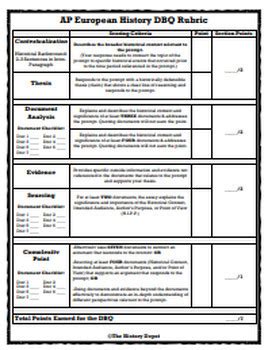Introduction
The Document-Based Question (DBQ) is a crucial component of the Advanced Placement (AP) European History exam. It assesses students’ abilities to analyze historical documents, construct a cogent argument, and demonstrate their understanding of European history during the period 1450-1989. This article provides a comprehensive guide to the DBQ AP Euro rubric, empowering students with the knowledge and skills to excel on this challenging task.

Rubric Overview
The DBQ AP Euro rubric comprises seven criteria, each with a specific point value:
| Criteria | Points | Description |
|---|---|---|
| Thesis/Claim | 1 | Presents a clear and focused thesis statement that responds to the prompt. |
| Contextualization | 1 | Provides historical context for the documents and the period under study. |
| Evidence | 5 | Accurately cites evidence from multiple documents to support the thesis. |
| Analysis | 5 | Analyzes the documents’ perspectives, biases, and limitations. |
| Outside Information | 1 | Integrates relevant outside knowledge to enhance the analysis. |
| Complexity | 1 | Demonstrates a sophisticated understanding of the historical era and its complexities. |
| Clarity | 1 | Presents a well-organized and coherent essay with clear prose and transitions. |
Criteria Breakdown
1. Thesis/Claim:
– Develop a thesis that directly addresses the prompt and provides a specific historical argument.
– Avoid using vague or overly broad statements.
– Ensure that the thesis is arguable and can be supported by evidence.
2. Contextualization:
– Provide a concise historical overview of the era and topic covered by the prompt.
– Explain the significance of the events or developments that led to the situation addressed in the documents.
3. Evidence:
– Identify and cite specific evidence from multiple documents that support your thesis.
– Avoid relying solely on paraphrasing or repetition.
– Explain how the evidence contributes to your argument and supports your claims.
4. Analysis:
– Examine the perspectives, biases, and limitations of the documents.
– Discuss the credibility of each document and how it influences your interpretation.
– Consider the historical context and how it might have shaped the documents’ perspectives.
5. Outside Information:
– Incorporate relevant information from your outside knowledge that complements the primary sources provided in the documents.
– Use outside knowledge to provide additional context or support for your analysis.
6. Complexity:
– Demonstrate an understanding of the historical era by examining the complexities of the situation and considering multiple perspectives.
– Discuss different interpretations of the events and how they influenced historical outcomes.
7. Clarity:
– Organize your essay logically and provide clear transitions between paragraphs.
– Use precise language and avoid ambiguous or confusing phrasing.
– Proofread your essay carefully to ensure that it is easy to read and understand.
Tips for Success
- Practice regularly: Timed practice is essential to improve your writing speed and organization skills.
- Understand the prompt: Read the prompt carefully and ensure you understand the specific question being asked.
- Read the documents thoroughly: Analyze the documents for their context, purpose, and significance.
- Develop a strong thesis: Craft a clear and specific thesis that provides a roadmap for your essay.
- Use evidence effectively: Citing specific evidence from the documents is crucial for supporting your argument.
- Analyze documents critically: Examine the documents’ perspectives, biases, and limitations to provide a balanced analysis.
- Incorporate outside knowledge: Supplement your analysis with relevant outside knowledge to enhance your argument.
- Manage your time: Allocate your time wisely during the exam to ensure you have sufficient time to complete all seven criteria.
Conclusion
Mastering the DBQ AP Euro rubric is essential for achieving success on the AP European History exam. By understanding the criteria and developing strong writing skills, students can effectively analyze historical documents and construct cogent arguments. Practice, preparation, and adherence to the rubric’s guidelines will empower students to excel on this challenging task and demonstrate their deep understanding of European history.
